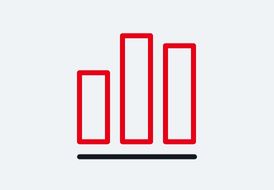Development in the relevant markets
Land transport
Europe
- In 2022, the European land transport market was characterized by freight rates at record highs, scarce capacity and continued high demand for transport.
- High demand was met by a shortage and an increase in the price of transport supply, caused particularly by a driver shortage and rising diesel and energy prices. As a result, the transport price level rose noticeably, fueled in particular by the war in Ukraine and strong inflation. Shipment flows also changed slightly from intercontinental to more intra-European flows. Investments in digital platforms for consolidating supply and demand of transport capacities added to the existing pressure on margins caused by intense competition. In late 2022, there were recession expectations on the market, driven by the already falling figures for industrial production, which, however, had not yet had an impact on transport demand.
- DB Schenker maintained its market-leading position.
Americas
- After very dynamic development in the first half of 2022, the market in the USA and Canada has settled down considerably again. The availability of full-load capacity for trucks increased significantly in the first nine months. As a result, spot rates, i.e. non-contractually regulated transport prices, fell sharply. In the USA, inventory stocks of consumer goods were high until the end of the third quarter and in the fourth quarter. Combined with inflationary pressure and the slowdown in the housing market, this leads to a further dampening of transport demand.
- Volumes in Mexico and Canada generally followed trends in the USA, albeit to a much lesser extent than in North America as a whole.
Asia/Pacific
- Domestic transport business has seen a sharp increase in demand, in China in particular, following the lifting of Covid-19-related restrictions. The opening of borders also had a positive effect on intra-Asian land transport, but the increase was somewhat dampened by price and capacity developments in air and ocean freight.
- The transport business in the Eurasian corridor has collapsed sharply since the beginning of the war in Ukraine and recorded a decline in revenues of over 30%.
Air freight
After a strong start in 2022, in which the strong previous year’s figures were exceeded in the first quarter, air freight could not escape the general macroeconomic conditions during the course of the year. In particular, declining demand for transport, the war in Ukraine and Covid-19 restrictions in China had a negative impact on the market. Overall, the volume transported in air freight fell slightly in 2022 (–4.6%).
Signs of a slowdown in demand were already observed in the summer months of 2022. This trend continued and accelerated in the last quarter of 2022. At the same time, as capacity increased, the market balance between supply and demand shifted on most routes. In this increasingly challenging market environment, DB Schenker recorded a decline in volume slightly above the level of the overall market.
Ocean freight
After a successful first half of 2022, the second half of 2022 was characterized by sharply falling ocean freight rates and volumes. The war in Ukraine put energy costs in Europe under pressure. Rising inflation and fully utilized warehouses also weakened demand for transport as import volumes fell. At the same time as transport capacity increased, freight rates fell: after peaking in January 2022, freight rates on all main trade routes from Asia have fallen by 80%, with rates almost back at pre-Covid-19 levels in early 2023. The ending of strikes and the easing of congestion at ports increased the reliability of shipping companies and the punctuality of transport.
The volumes at DB Schenker declined as a result of the challenges that had arisen, but development was on an equal footing with the competition.
Contract logistics
After recovering to pre-Covid-19 levels, the market for contract logistics continued to grow in 2022. The e-commerce (omnichannel), healthcare, electronics (5 G, cloud, microchips) and consumer goods sectors developed positively. The automotive industry, on the other hand, performed below average.
Despite high investments in recent years, there has been a global shortage of available storage space, largely due to the Covid-19-related growth in e-commerce and healthcare. Investments in new storage capacities are currently declining due to sharply higher prices for construction materials, scarce construction space and rising cost of materials and financing.
DB Schenker recorded a slight increase in its market share due to its geographically and sectorally diversified portfolio, particularly in the Middle East and Africa and Asia/Pacific regions.


